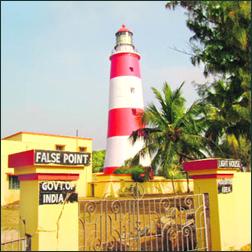Kendrapara: False point, an old harbor with a lighthouse about 45 km from Kendrapara district will soon get a facelift to help increase the footfall of tourists. The False Point lighthouse situated about 45 km from the district headquarters is near the Kharinasi river bank north of the Mahanadi estuary. The lighthouse is situated on a large island created by the Mahanadi river delta. Like most harbors, False Point too has a lighthouse but what makes it so special is the fact that it is the first lighthouse installed on the eastern coast of India. The construction of the lighthouse commenced in 1819 and concluded in 1826.
Reports said that attractive galleries, a jetty, a rest house, and Jatri Nivas for providing accommodation to visitors will be constructed to attract tourists to the site. Moreover, a market will be established in the area incorporating the local culture. The whole island will be electrified with solar power.
All these developmental works will be implemented in public-private partnership (PPP) mode at an expenditure of Rs 10,000 crore. The revelation was made by Union Minister of Ports, Shipping and Highways Sarbananda Sonowal in reply to a question in the Parliament, Friday.
As the project comes under the Coastal Regulation Zone (CRZ) a letter has been written to the office of the CRZ authority seeking its permission to implement the projects, the minister informed during his reply. A total of 65 lighthouses in the country including the ones in Paradip, Gopalpur, Chandrabhaga, Puri, and False Point in Kendrapara will be developed and upgraded under the Centre’s ambitious Sagarmala project, the minister said.
However, except for False Point, the rest four lighthouses in Odisha have roads to commute and accommodations for visiting tourists. This is the reason why the rest four lighthouses witness a large footfall of tourists every year while the Kharinasi bridge has been a roadblock for visitors to the False Point lighthouse. The False Point lighthouse after its renovation will provide a veritable atmosphere for tourists to witness the mangrove forests, estuarine crocodiles, and marine and other wildlife in its surroundings.
Sources said that the lighthouse was re-constructed in 1836 after it got damaged. The lighthouse was lit up with petroleum gas October 16, 1836. The lighthouse named as Diopetria was inaugurated by then-Bengal Governor General Sir Ashley Eden in 1880. The last few decades saw generators being used to light up the lighthouse whereas now, a power supply has been made available to the lighthouse. The lighthouse having a height of 125 metres was constructed with stone available at Barabati fort in Cuttack.
To reach the top, one has to climb 138 steps and a 16-step ladder. The specialty of this lighthouse is that it has remained operational from the date of its lighting. There are some clusters of graves and a well on the premises of the lighthouse. The lighthouse is surrounded by mangrove forests on a small island threatened by rapid coastal erosion. Prawn gherries have mushroomed and illegal intrusion is taking place due to the negligence of the administration.
Senior residents said that if the island where the lighthouse is situated is developed then it will be of benefit for the residents and provide great employment opportunities to the local youths by pulling tourists.

